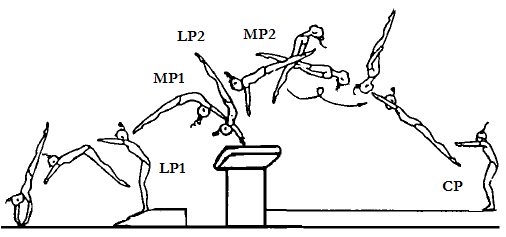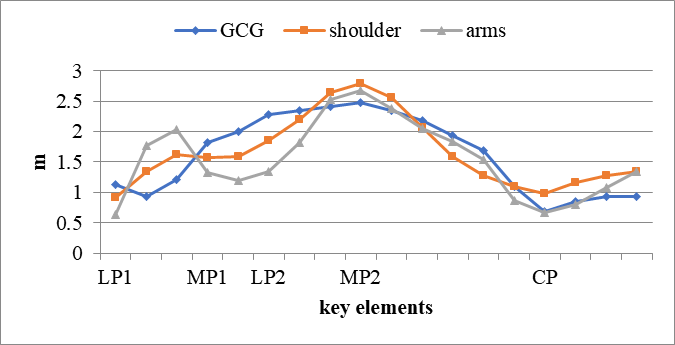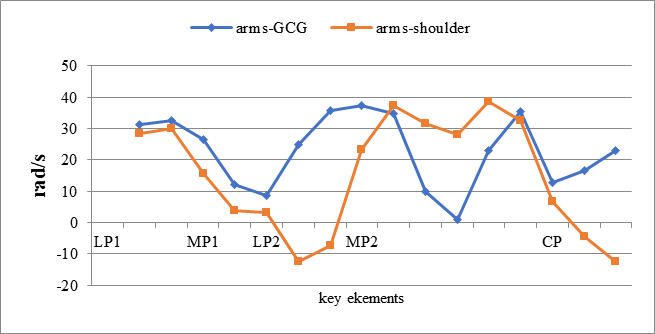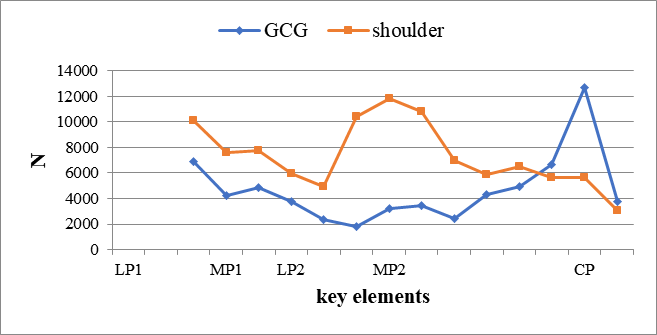Abstract
This study highlights the relationship of the biomechanical characteristics and the movement radius of body segments during the execution of Yurchenko handspring vault by the female gymnasts of 14-16 years old. Thus an experimental study was conducted in 2014 at the “Sidney 2000” Olympic Centre of Izvorani, with a group of 7 gymnasts aged 14 to 16, belonging to the national women’s artistic gymnastics team. Research methods: review of the specialised literature; pedagogical observation; experimental study method; computerised video method using Kinovea and Physics ToolKit specialised programs; method of postural orientation movement for sports technique analysis; statistical-mathematical method and graphical representation of data with KyPlot program. The results of the study show the relationship of the kinematic and dynamic characteristics of sports technique key elements and the body segments movement radius during the Yurchenko vault. It also shows the influence of arm movement radius related to the other body segments on the technical execution depending on the vault difficulty and type and the performances achieved in competition. Regarding the correlation of the biomechanical characteristics indicators with the performances in handspring vaults, we notice significant differences at p<0.05, p<0.01 and p<0.001, which confirm the influence of arm radius and body segment movement on the technical execution of the handspring vaults in the gymnasts of 14-16 years old.
Keywords: Handspring vaultsbiomechanicsmovement radiuscorrelationperformance
Introduction
Nowadays, the artistic gymnastics develops in accordance with the regulations and trends of the sport worldwide (Arkaev & Suchilin, 2004). Women’s artistic gymnastics reached a very high level in terms of difficulty and content of the exercises on apparatus. The changes in the Code of Points (FIG, 2017) regarding the technical elements on each apparatus entailed mainly the diminution of the specific technical requirements (dismounts off apparatus) and decrease of the difficulty value in handspring vaults.
The handspring vaults is the most dynamic and athletic event in the gymnastics polyathlon, but also the shorter one (Vieru, 1997), where the exercises are executed through handstand position. They belong to the basic technical structural group of the handspring vaults with variants (forward rollover, Tsukahara, Yurchenko etc.).
The analysis of the specialised literature regarding the current concerns in the scientific research on biomechanics applied to women’s artistic gymnastics, particularly to handspring vaults (Prassas, Kwon, & Sands, 2006; Knudson, 2007), reveals the presence of numerous studies advocating the use of the modern technology which helps to understand more thoroughly the phasic structure of the key elements of sports technique, the kinematic and dynamic characteristics of the exercises, the inner mechanisms of movements – namely the inertia of rotation and the radius of movement.
It is also highly important to know the influence of arm work on the technical execution in the phasic structure of Yurchenko vault, both the relationship of the inertia of rotation and the radius of movement of the entire body segments and also of the arms separately.
Problem Statement
The general issues of biomechanical analysis of current sports technique, the decisive factors for technical training and the content of training improvement in gymnastics are insufficiently addressed and known in the specialised literature (Smolevskij & Gaverdovskij, 1999; Grigore, 2001; Readhead, 2011; Gaverdovskij, 2014). Under the present circumstances, the sport and the potential for performance undergo deep mutations with major implications not only in the strategies of selection and sports training (Manolachi, 2018), but also in terms of training methods based on multiple information about the technique of movement execution (Crețu, Simăn, & Bărbuceanu, 2004).
A practical methodology (macro-methods) of gymnastics exercises learning was created to this end. It involves a functional unity of the elements of long-term programs for learning the exercises in the movement school, basic level, specialisation, competitive exercises on apparatus by integrating the motor, biomechanical, didactical and technological structures of the gymnastics with different complexity and difficulty of coordination (Boloban & Potop, 2015; Potop, 2015).
In elite artistic gymnastics, a particular attention is given to acrobatic vaults and to their combination because the vaults difficulty and value are judged with respect to both height and length of the flights, especially the second one, and depending on the twists performed in different axes during the flights (Filipenco, Tomşa, & Buftea, 2014).
Research Questions
In order to conduct our research, we have proposed the following questions:
Will the computerised video analysis of Yurchenko vault highlight the biomechanical indicators necessary for the analysis of sports technique in female gymnasts aged 14-16 years, in conformity with the method of movement postural orientation?
Will the exemplification of the individual values of the biomechanical characteristics of the technical key elements in Yurchenko vault 360º twisting back salto stretched, depending on the axis of rotation, highlight the relationship of the values in the execution of the phasic structure?
Will the correlative analysis of the biomechanical characteristics indicators of technical key elements and the movement radius of body segments in Yurchenko vault reveal the level of connection between indicators and their influence on the performances achieved in competitions?
Purpose of the Study
This study intends to reveal the relationship of the biomechanical characteristics and the movement radius of body segments during the execution of Yurchenko handspring vault by the female gymnasts of 14-16 years old.
Research Methods
Methods of research: review of the specialised literature; method of pedagogical observation; method of experimental study; computerised video method using the Kinovea and Physics ToolKit specialised programs; method of postural orientation movement for the analysis of sports technique (Boloban, 2013); statistical-mathematical method (Thomas & Nelson, 1996) – KyPlot program for parametric (Pearson) and graphical representation of data by means of excel software.
Thus an experimental study was conducted in 2014, at the “Sidney 2000” Olympic Centre of Izvorani, with a group of 7 gymnasts aged 14 to 16, belonging to the national women’s artistic gymnastics team. To show the relationship of the biomechanical characteristics and the radius of body segments movement specific to Yurchenko handspring vault performed by the female gymnasts of 14-16 years old in competition conditions, a number of 10 Yurchenko type handspring vaults (namely 3 – salto stretched YSS, 4 – 360º twisting salto stretched YSS 360° and 4 – YSS 720°) were analysed in terms of biomechanics. These vaults were executed at the Romanian National Championships of Bucharest, 2014.
The control exercises and their phasic structure applied in this research were used in the key elements analysis of Yurchenko round-off vault with salto backward layout, in terms of biomechanics. Their functional structure and causes were considered all together as a characteristic of the translation and rotation movement of body segments around the GCG axis (Figure

In order to show the biomechanical characteristics of movement radius of body segments (toes, shoulder and arms) around the axis of rotation of GCG and of movement radius of arms - axis of rotation of shoulder joints, we made a correlative analysis of the studied indicators using the KyPlot program of statistical calculation Parametric test Linear Correlation – Pearson. The indicators are listed below:
Biomechanical indices required by the analysis of: body rotation inertia (IR, kg∙m2) (½ position arms up standing) and arms* (3.4% of the body weight and length of arms – mean 0.45 m), radius of movement (RM, m) of body segments (toes, shoulder and arms) and RM of arms* with shoulder rotation axis.
Angular characteristics of sports technique main elements (Figure
01 ): LP1 – launching body posture 1 – angle between ankle – shoulders joints; MP1 – multiplication of body posture 1 – angle of toes – shoulders; LP2 – launching body posture 2 – angle between hand joint – foot 2; MP2 – multiplication of the body posture 2 – angle of hip - torso; CP – concluding body posture, landing – angle of hip – torso.Spatial characteristics of the trajectory of body segments movement (m): LP1 – shoulders, MP1 –maximum height of GCG flight, LP2 – toes, MP2 – maximum height of GCG flight and shoulders – CP.
Kinematic characteristics of the angular speed (rad/s): LP1 – shoulders, MP1 – arms and toes, LP2 – toes, MP2 – arms, shoulders and toes; CP – arms, shoulders and toes.
Dynamic characteristics of the resultant of the force of GCG movement (N) in all key elements of vaults phases.
Performances achieved in the handspring vaults event during the Romanian National Championships of Women’s Artistic Gymnastics, Bucharest, 2014, regarding the difficulty, execution and final score on this apparatus.
Findings
As for the Yurchenko vaults, most authors (Bruggmann, 1994; Penitente, Sands, McNeal, Smith, & Kimmel, 2010; Potop, 2013; Potop, Mihăilă, & Urichianu, 2015) address the biomechanical comparison of this vault type and two related teaching exercises, the optimisation of the technique main elements resulted from the biomechanical analysis, the kinematics in the springboard phase, the e-learning by video analysis, the use of e-training in mathematics modelling of the biomechanical characteristics etc.
Table
The results of the statistical calculations reveal the following data: (mean; ±SD, n=10) 17.39;±3.33 kg·m2of body inertia of rotation (IR), de 0.26; ±0.03 kg·m2of arms IR around shoulders axis, radius of movement (RM) of body segments: toes 0.69; ±0.06 m, shoulder – 0.39; ±0.03 m, arms – 0.48; ±0.05 m and RM – arms – rotation axis of shoulders – 0.36; ±0.06 m. Regarding the coefficient of variation (Cv%) we notice a high homogeneity at IR of arms and RM toes, shoulder and arms – GCG rotation axis and poor homogeneity of body IR and RM of arms – shoulders axis of rotation.
We shall present hereby some individualised examples meant to highlight the biomechanical characteristics in the phasic structure of the sports technique key elements of Yurchenko vault regarding the radius of movement of body segments and arms as well, related to the axis of rotation of GCG and shoulders.
Figure

Figure

The analysis of the individual values concerning the relation of the angular velocity of arms – GCG and arms – shoulders reveals, in the launching posture of the body (LP1) a value of 31.23 rad/s of the relation arms – GCG compared to 28.55 rad/s arms – shoulders, multiplication of body posture (MP1-flight 1) of 26.58 rad/s and 15.53 rad/s, launching posture of the body (LP2) of 8.63 rad/s and 3.07 rad/s, multiplication of body posture of (MP2 flight 2 – maximum height of GCG) of 37.49 rad/s and 23.23 rad/s and the concluding posture (CP) – landing, 12.83 rad/s and 6.62 rad/s.
Figure
The individual results of the resultant of force (F, N) of GCG and shoulders movement highlight in MP1 – flight 1 a value of 4270 N at GCG and 7630 N at shoulders, in MP2 – flight 2, the value F, shoulders – oscillates between 3200-6670 N and increases up to the value of 12700 N before damping and sticking the landing; instead, F of shoulders decreases from 11800 – 5670 N.

Table 03 includes the results of the linear correaltive analysis between the inertia of rotation, the movement radius of arms, the biomechanical indicators of Yurchenko vault and the performances achieved in the handspring vaults event.
During the correlative analysis, we selected 36 biomechanical indicators considered as more important for highlighting the influence of the correct technical execution of Yurchenko handspring vault. Data of the indicators of the kinematic and dynamic characteristics of Yurchenko handspring vault were processed by means of the computerised video programs Physics Toolkit and Kinovea, in accordance with the method of analysis of movement postural orientation sports technique (Boloban, 2013).
The results of the correlative analysis between the inertia of rotation and movement radius indicators and the biomechanical indicators of Yurchenko handspring vault reveal the following elements (Table
Inertia of rotation of arms (IR, kg•m2) has strong connections at p<0.001 with IR of the body r=.942, trajectory of shoulders in LP1, (Y, m) r=.942, with the trajectory of toes in LP2 (Y, m) r=.896 and with the trajectory of GCG in MP2 (Y, m) r=.833; strong connections at p<0.05 with the resultant of force GCG in CP (F, N) – landing r=.750. Moderate connections with RM, toes (m) r=.585, with the trajectory of the toes in LP2 (X, m) r=-.559 and with the resultant of force GCG in MP1 (F, N) r=.598, while the other indicators show insignificant poor connections or even inexistent ones at p>0.05.
Radius of arms movement in the axis of rotation of shoulders (IR, kg•m2) has strong connections at p<0.001 with hip-torso angle in MP1 (grade) r=.882; strong connections at p<0.01 with hip-torso angle in CP - landing (degrees) r=.796, with shoulders trajectory in CP – landing (X, m) r= .778, with angular velocity of arms in MP1 (rad/s) r=-.836, with resultant of force of GCG in MP2 (F, N) r=.796, with the difficulty of vault (points) r=-.844; strong connections at p<0.05 with RM of shoulders (m) r=.698, RM of arms (m) r=.654, with hip-torso angle in MP2 (degrees) r=-.661, with the resultant of force of GCG in LP2 (F, N) r=-.649 and with the final score (points) r=-.721. Moderate connections with the angular velocity of shoulders in LP1 (rad/s) r=-.602, with the angular velocity of toes in MP2 (rad/s) r=.628, with the angular velocity of toes in CP – landing (rad/s) r=.628, with the resultant of force of GCG in LP1 (F, N) r=-.601 and with the resultant of force of GCG in MP1 (F, N) r=.521 while the other indicators have insignificant poor or even inexistent connections at p>0.05.
The results of the correlative analysis between the inertia of rotation and the biomechanical indicators of Yurchenko vault reveal strong connections and positive influences on the technical execution in the phasic structure regarding the hurdle onto springboard (LP1), handstand on apparatus while making the Corbett (LP2), maximum height of GCG (MP2) and sticking the landing (CP).
The results of the correlative analysis between the radius of arm movement and the biomechanical indicators of Yurchenko vault prove the existence of strong connections and positive influences on the technical execution in the phasic structure regarding the radius of movement of the shoulders and arms, trajectory of GCG and angular velocity of arms in MP1 – flight 1, resultant of force in the execution of Corbett from handstand on apparatus (LP2), posture of the body, resultant of the force of movement of GCG and the length of flight 2 depending on the difficulty of the vault (stretched salto, with 360º and 720º twisting) and angular posture in CP – at landing that influence the final score.
Conclusion
The computerised video analysis of Yurchenko vault executed by the female gymnasts of 14-16 years old, consistent with the method of movement postural orientation, identified the biomechanical indicators needed by the analysis of sports technique.
The results of the individual values of the biomechanical characteristics of the key elements of sports technique in Yurchenko vault with 360° twisting back salto stretched, depending on the axis of rotation, highlighted the relation of the values on the execution of the phasic structure.
Regarding the correlation of the indicators of biomechanical characteristics with the performances obtained in handspring vaults, we notice significant differences at P<0.05, P<0.01 and P<0.001, which confirm the influence of the radius of arm and body segment movement on the technical execution of the handspring vaults in the gymnasts of 14-16 years old.
Acknowledgments
This case study is an advanced stage of the pedagogical experiment of the first author post-doctoral studies; it is included in the research plan of the National University of Physical Education and Sport of Ukraine, with the subject matters: 2.32 (Technical training of skilled athletes based on competitive exercises technique rationalization) and in the plan of research for 2017-2018 of the Faculty of Physical Education and Sport, Ecological University of Bucharest. We express our gratitude to the Romanian Gymnastics Federation and especially to Mrs Anca Grigoraș Mihăilescu – Federal Coach – and to the coaches of the Olympic Team at the time who helped us conduct this research.
References
- Arkaev, L. J., & Suchilin, N. G. (2004). Kak gotovit’ chempionov. Teorija I tehnologija podgotovkigimnastov vyshej kvalifikacii [How to create champions. Theory and technology of training. Top-class gymnasts]. Moscow: Fizkul’tura i Sport.
- Boloban, V. N. (2013). Reguliaciia pozy tela sportsmen [Regulation of athlete’s body posture]. (Monograph). Kiev: Olympic Literature.
- Boloban, V., & Potop, V. (2015). Osnovy makrometodiki obuchenija sportivnym uprazhnenijam (na materiale zhenskih vidov gimnasticheskogo mnogobor’ja) [Bases of macro-methods of sports exercise training (as exemplified in woman’s all-around gymnastics)]. Science in Olympic Sport, 7(4), 55-66.
- Bruggmann, G. P. (1994). Biomechanics of gymnastics techniques. Sport Science Review, 3(2), 79-120.
- Creţu, M., Simăn, I. I., & Bărbuceanu, M. (2004). Biomecanica giganticii înapoi la paralele inegale. Piteşti: Editura Universității din Pitești.
- FIG. (2017). Code of Points 2017-2020. Women’s Artistic Gymnastics (Part III. Apparatus, Section 10: Handspring vaults, pp. 40-43; Part IV: Tables of elements, pp. 57-71).
- Gaverdovskij, J. K. (2014). Theory and methods of artistic gymnastics (Vol. 1). Moscow: Sov. Sport.
- Grigore, V. (2001). Gimnastică artistică. Bazele teoretice ale antrenamentului sportiv. București: Semne.
- Filipenco, E., Tomşa, N., & Buftea V. (2014). Gimnastica. Recomandări metodice pentru studenții USEFS privind studiul cursului teoretic şi practico-metodic programat la săriturile cu sprijin. Chișinău: USEFS.
- Knudson, D. (2007). Fundamentals of biomechanics (2nd ed.). New York: Springer.
- Manolachi, V. (2018). Teoria și didactica sportului feminin (evaluare, planificare, dirijare și nutriție). (Monografie). București: Discobolul.
- Penitente, G., Sands, W. C., McNeal, J., Smith, S. L., & Kimmel, W. (2010). Investigation of hand contact forces of female gymnasts performing a handspring vault. International Journal of Sports Science and Engineering, 4(1), 15-24.
- Potop, V. (2015). Bases of macro methods for sports exercises learning (Material from Women’s Artistic Gymnastics) (Monograph). Kiev: Centre of Education Literature.
- Potop, V. (2013). E-learning by computer video analysis the key elements of sports technique of Yurchenko vault in Women’s Artistic Gymnastics. In The 9th International Scientific Conference eLearning and Software for Education, April 25-26, 2013 (Vol. 3, pp. 151-158). Bucharest: “Carol I” National Defence University. doi: 10.12753/2066-026X-13-239
- Potop, V., Mihăilă, J.-M., & Urichianu, A. (2015). Using e-training in mathematics modeling of the biomechanical characteristics of Yurchenko vault. In The 11th International Scientific Conference eLearning and Software for Education, April 23-24, 2015 (Vol. 3, pp. 298-305). Bucharest: “Carol I” National Defence University. doi: 10.12753/2066-026X-15-226
- Prassas, S., Kwon, Y. H., & Sands, W. (2006). Biomechanical research in artistic gymnastics. Journal of Sport Biomechanics, 5(2), 261-291.
- Readhead, L. (2011). Gymnastics: Skills, technique, training. Marlborough: The Crowood Press.
- Smolevskij, V. M, & Gaverdovskij, J. K. (1999). Sportivnaja gimnastika [Artistic gymnastics]. Kiev: Olimpijskaja Literature.
- Thomas, J. R., & Nelson, J. K. (1996). Research methods in physical activity (2nd ed.). Human Kinetics.
- Vieru, N. (1997). Manual de gimnastică sportivă. București: Driada.
Copyright information

This work is licensed under a Creative Commons Attribution-NonCommercial-NoDerivatives 4.0 International License.
About this article
Publication Date
16 February 2019
Article Doi
eBook ISBN
978-1-80296-054-9
Publisher
Future Academy
Volume
55
Print ISBN (optional)
-
Edition Number
1st Edition
Pages
1-752
Subjects
Sports, sport science, physical education
Cite this article as:
Potop, V., Crețu, M., Boloban, V., Buftea, V., & Jurat, V. (2019). Biomechanical Characteristics Of Movement Radius In Yurchenko Handspring Vault. In V. Grigore, M. Stănescu, M. Stoicescu, & L. Popescu (Eds.), Education and Sports Science in the 21st Century, vol 55. European Proceedings of Social and Behavioural Sciences (pp. 247-255). Future Academy. https://doi.org/10.15405/epsbs.2019.02.31
